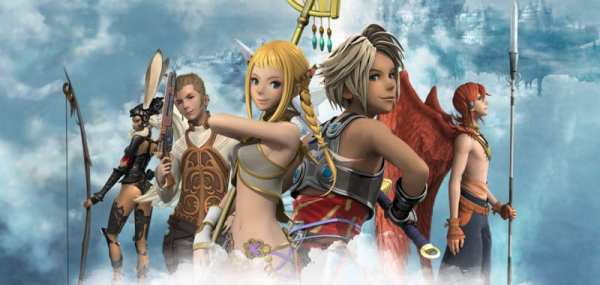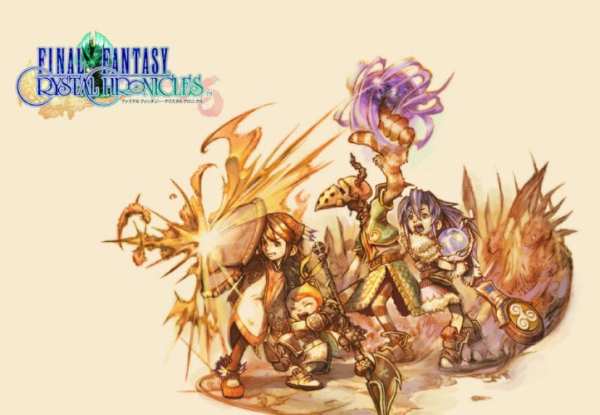5) Final Fantasy XII: Revenant Wings
Revenant Wings was another entirely unexpected spinoff. The game takes place one year after the events of Final Fantasy XII and focuses on the characters Vaan and Penelo who have now become sky pirates with their very own airship. That’s right. No more Vaan saying “I’m gonna be a sky pirate!”
Vaan and Penelo both get a little better characterization than they had in the full title, and other characters from XII appear throughout the story. In Revenant Wings, they explore a mysterious floating continent called Lemures, and the pair ventures forth to find the riches that might lie in wait in this new land. A race of winged humans called Aegyl inhabit the continent, one of which becomes one of the new main characters of the game.
The story of Revenant Wings adds in some interesting new characters and it’s great to see some of the party come back together, but the game really shines with its gameplay. Revenant Wings is actually a real-time strategy game, where you’d control your characters with the stylus on the bottom touch screen of the DS. Points could be captured on maps that would spawn additional friendly monsters, and summons can even be used to call in some serious help.
Battles could quickly become hectic, with you trying to keep on top of every facet of a battle. There were also three different unit types to add another layer of strategy – melee, ranged, and flying. Even though Revenant Wings was a follow up to XII, its art style was very similar to that of the Final Fantasy Tactics Advance games, and its story tone tends to match that more as well. Revenant Wings was a fun continuation of some of the characters’ stories from XII, and its combat system is entirely unique for the Final Fantasy series.
4) Dissidia 012 (Duodecim)
Dissidia sounds like every Final Fantasy fan’s dream. Take the main heroes and villains from every game in the series, throw in a few others, and make them all fight each other. For the most part, the Dissidia games succeeded on that vision as well.
Dissidia is a bit different for a fighting game. Two characters pit off against each other in an arena that they can freely move and dash around in. Two different kinds of attacks called Bravery and HP attacks are at the player’s disposal, and these attacks lower the opponent’s count of each respectively. The more Bravery points you have, the more damage you do when you land an HP attack. Each character also has a huge amount of abilities, levels, assist characters, and equippable items that can help change the tide of battle.
The sense of speed in battles is a huge draw to Dissidia; the battles are hectic and fast-paced, requiring players to stay on their toes the whole time. Of course the biggest appeal is being able to play as your favorite Final Fantasy heroes and villains. Dissidia 012 has a huge cast of characters, clocking in at 31 playable characters from Final Fantasy 1-13.
Dissidia’s story casts all these characters in a huge war between Chaos and Cosmos, basically as warriors of light and darkness. The story manages to be confusing at a lot of turns, but Dissidia actually has a pretty expansive single player offering that can last upward of 60 hours. Dissidia 012 functions as a prologue to the original game, which you actually unlock after beating the story of 012. You travel a world map as story scenarios play out, and can undertake additional objectives and battles to help train your characters.
3) Final Fantasy VII: Crisis Core
Final Fantasy VII is one of the most beloved entries in the entire series, case in point the remake that was announced last year at E3. In the early 2ooos, Square Enix announced a project called “Compilation of Final Fantasy 7.” This was a metaseries of different pieces of entertainment that would add onto the story and lore of FF7.
The metaseries contained things like the film Advent Children and a mobile game only released in Japan called Before Crisis. Of course one of the biggest pieces of the compilation was Crisis Core, a prequel game to FF7 that would finally flesh out the story of Zack Fair, Cloud’s friend and former colleague in SOLDIER.
Zack was one of the most underdeveloped characters in the main game that held more of a connection to 7’s events than we even knew before Crisis Core. Of course, it’s a very melancholic experience as the death of Zack was something already known. Crisis Core gave us a look at the infamous Sephiroth when he was still a member of SOLDIER and seen as a hero, and also introduced us to two new important characters named Angeal and Genesis. It did a great job of fleshing out the world of FF7, and giving fans more insight into characters and what happened before the main game, adding another wrinkle into things with the new characters and villains it introduced. On top of this, Zack was a charming character that you just couldn’t help but sympathize with.
Crisis Core went a different direction from 7 gameplay wise, and had a much more action oriented style with a slot machine kind of minigame thrown into the mix. It focused entirely on Zack as the playable character and gave him different attacks, magic, and summons to use in battle. Crisis Core’s battle system would go on to inspire pieces of how Type-0 would play out.
2) Crystal Chronicles
Crystal Chronicles was a fascinating step for Square Enix, and a game that spawned an entirely new sub-series of Final Fantasy games. Sporting a beautifully charming new art style, Crystal Chronicles introduced us to a whole new world and gameplay style.
Instead of the normal turn-based combat, the game had a faster-paced hack and slash kind of experience. Battles happened seamlessly instead of the game cutting away to another screen, and there was even incredibly fun co-operative multiplayer. Magic still heavily influenced the battle system, with ‘Magicite’ giving you access to basic spells that you can then combine into stronger ones. Exploration and adventure was still a huge focus as you explored a colorful world via an overworld map, and smaller areas.
A diverse cast of races was introduced with the Clavats, Lilites, Selkies, and Yukes that would carry over to the worlds of all the other Crystal Chronicles games made. Players could create their own character out of any of the four races in the game. In the story of the game, you’re thrust into the shoes of a member of a “Crystal Caravan.” These caravans travel the world seeking something called Myrrh that will strengthen the power of crystals protecting the towns and cities.
Traveling the world of Crystal Chronicles and learning about the different races and cultures is one of the huge draws of the game even with an overarching plot. The battle system and multiplayer just helped to make an already great game even more enjoyable.
1) Final Fantasy Tactics

If there’s one game that really popularized isometric strategy games, it was Final Fantasy Tactics. Yasumi Matsuno the creator of the game, had previously worked on the Tactics Ogre series, a highly overlooked series in the same vein. But Final Fantasy Tactics really surged the genre forward, and for years other games have taken it and Tactics Ogre’s cue and adopted much of their gameplay style.
Final Fantasy Tactics was the first game to introduce us to the land of Ivalice, a place we’d see return in many games afterward. Ivalice is a land torn apart by war and political intrigue, and these themes are present throughout Tactics’ story. The game is a dark tale of religious zealotry, political scheming and machination and family loyalty all revolving around one man named Ramza Beoulve. Tactics really does tell a grand sweeping story, with tons of characters that weave in and out of it. The story can be confusing at times, but has tons of twists and turns with a lot of strong character development for its main cast. The script of the game was made even better with the re-release on PSP called “The War of the Lions.”
Tactics is a game with an overwhelming amount of depth that few strategy-RPGs can meet even to this day. Battles take place on a 3D isometric grid, with your forces pitted against enemies. Characters have a wealth of different jobs you can assign in usual Final Fantasy fashion. There’s a staggering amount of variety when it comes to jobs, equipment, and abilities. You really can craft any kind of team you want, whether that’s a magic powerhouse team that can alter time and the environment or a melee blitz team that rushes into battle. Strategy is key with Tactics, as battles consistently challenge you over the 50+ hours you can play the game.
On top of everything else, Tactics is chock full of secret characters and Easter eggs, and has a dramatic soundtrack that perfectly matches the mood and spectacle of the story. The popularity and following for Tactics has only grown over the years, cementing it as one of the best entries in the entire Final Fantasy series and one of the best strategy games of all time.




